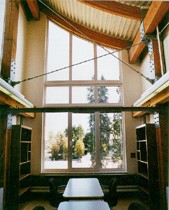By Bronwen Ledger
Article reprinted with the permission of Canadian Architect. The article appeared in the July 1996 issue of the magazine.
From the first planning meetings in 1993, the C.K. Choi Institute of Asian Research on the West Mall at UBC was designed to be a “benchmark in sustainable  design.”
design.”
As in any truly green building project, collaboration between all the consultants from the beginning was vital, since the work of each discipline affects another. Design charettes were held with the university administration, users and all the consultants making a contribution, and gradually the building began to take shape as a long, 30,000 s.f. structure, dominated by a series of swooping metal roofs and with a many-windowed brick facade.
Five atria below the curved roofs create a stack effect for natural ventilation. Air enters through operable windows and fresh air vents, rises and is carried up and out of louvers near the roof. The building relies entirely on this natural ventilation for cooling, with just a few fans to help push the air. The atria, windows and narrow floor plan also ensure that the building has large amounts of daylight, reducing the need for artificial lighting. Heat in winter is provided by the campus steam plant.
About 50 per cent of the materials in the building were reused or recycled. Heavy timbers were brought in from the nearby demolished Armouries building, and the cladding is reused red brick. Composting toilets enable the building to be disconnected from the campus sewer system, and save 1,500 gallons of potable water per day.
The occupants have been in the building since February, and so far it is working well. The director of the Institute, Terry McGee, is particularly pleased with the amount of natural light. He finds it has “really good light … even in the darkest days of a Vancouver winter.”